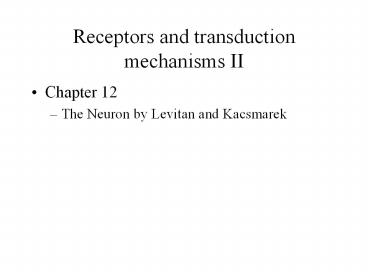Receptors and transduction mechanisms II - PowerPoint PPT Presentation
1 / 21
Title: Receptors and transduction mechanisms II
1
Receptors and transduction mechanisms II
- Chapter 12
- The Neuron by Levitan and Kacsmarek
2
Metabotropic receptors (G-protein-coupled
receptors, GPCR
3
Metabotropic receptors (G-protein-coupled
receptors, GPCR)
IN the case shown here, binding of
neurotransmitter (NT) to its receptor activates a
G protein that then interacts with an ion
channel, causing it to open
4
Second messenger-mediated receptor-channel
coupling
an intracellular second messenger influences ion
channel activity
5
GPCR coupling
These receptors are not directly coupled to their
ion channels and transduce the signal via guanyl
nucleotide-binding proteins (G-proteins) that
activate intracellular second messenger pathways
SLOW INDIRECT
6
Why are GPCR responses slower and longer lasting
than iR responses?
Allows a constant modification temporal
information processing
7
Generic GPCR structure
Why 7TMs?
8
Human b-adrenergic receptor
TMIII Asp (D113) binds to N-terminus of
epinephrine TMV two Ser (S204 S207) binds to 2
OH termini
9
(No Transcript)
10
Intracellular signal transduction by the PIP2
cascade
11
(No Transcript)
12
GPCR coupling can produce diverse responses
- Depends on type of G-protein and type of effector
- Single ligand can activate multiple GPCR pathways
- Depends on receptor numbers
13
Responses can be regulated by altering receptor
numbers
14
Desensitisation is a mechanism of decreasing the
cellular response to transmitter
Desensitisation is defined as the increase in
agonist required to produce ahalf-maximal
stimulation of effector
Brought about by receptor phosphorylation
- Physical removal by receptor-mediated endocytosis
15
Some types of GPCR
16
group I, II and III metabotropic glutamate (mGlu)
receptors
Trends in Pharmacological Sciences Volume 25,
Issue 5 , May 2004, Pages 265-272
17
Nature Reviews Drug Discovery 4, 131-144
(2005) Metabotropic glutamate receptors as novel
targets for anxiety and stress disorders
18
neurotransmitter pathways implicated in mediating
the actions of drugs of abuse (rat brain)
19
A metabotropic glutamate (mglu) receptor
associated with a heterotrimeric G protein
Residues that control the coupling of
metabotropic glutamate (mglu) receptors to G
proteins
Trends in Pharmacological Sciences Volume 22,
Issue 3 , 1 March 2001, Pages 114-120
20
group I, II and III metabotropic glutamate (mGlu)
receptors
neurotransmitter pathways implicated in mediating
the actions of drugs of abuse (rat brain)
21
1) G protein-mediated receptor-channel coupling.
IN the case shown here, binding of
neurotransmitter (NT) to its receptor activates a
G protein that then interacts with an ion
channel, causing it to open.
3) With second messenger coupling the binding of
a single transmitter can activate many channels,
activate several classes of channels and affect
other cellular processes not associated with ion
channels.
2) Second messenger-mediated receptor-channel
coupling an intracellular second messenger
influences ion channel activity.

